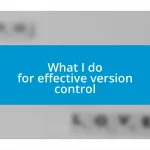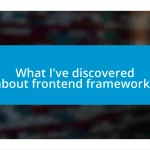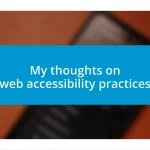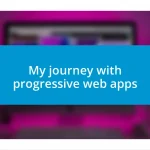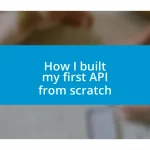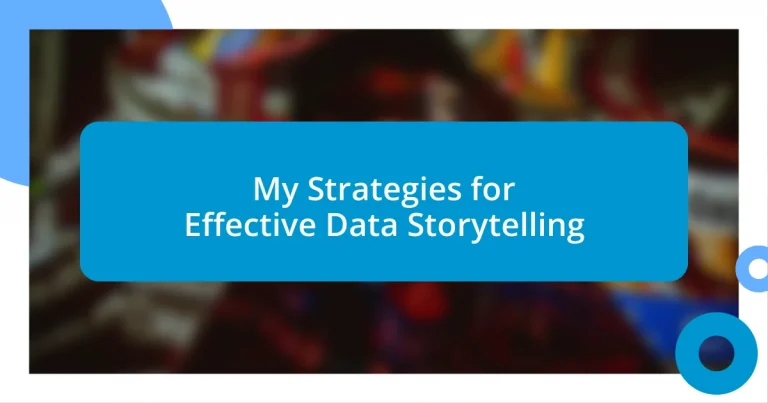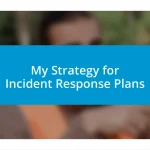Key takeaways:
- Data storytelling involves weaving narratives around data to create emotional connections and enhance audience engagement.
- Understanding audience needs and segmenting them based on expertise ensures that data presentations are relevant and comprehensible.
- Choosing clear visuals that complement the narrative and leveraging user-friendly analytics tools can significantly improve data interpretation and decision-making.
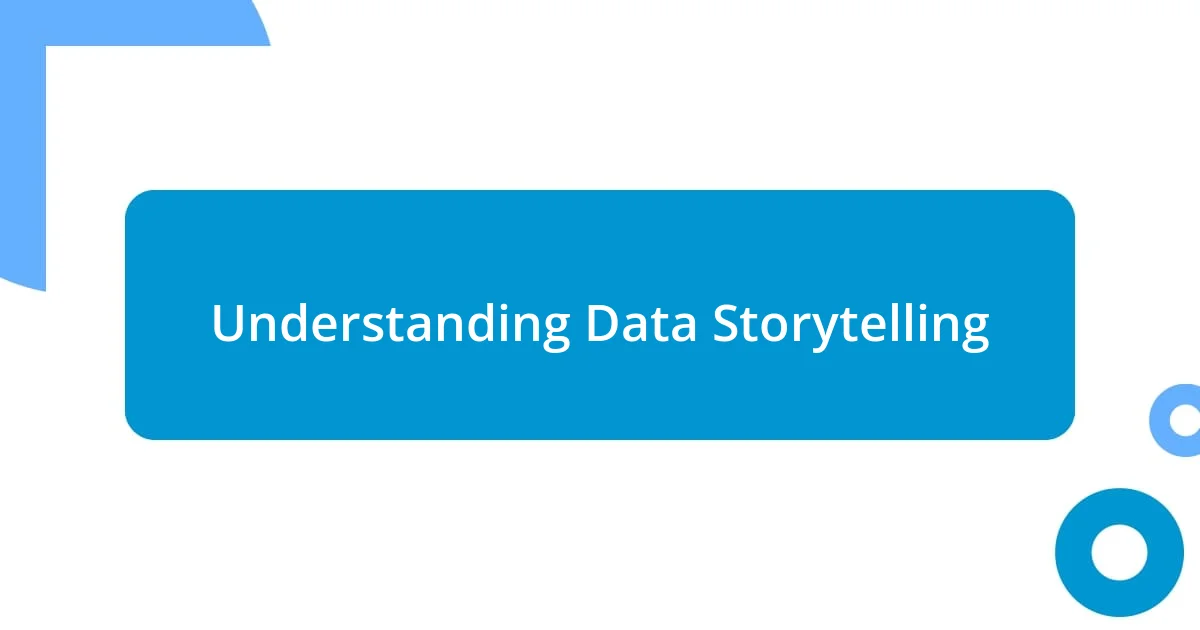
Understanding Data Storytelling
Understanding data storytelling goes beyond just presenting numbers and charts; it’s about weaving a narrative that resonates with your audience. I remember the first time I presented data-driven insights to a group. Initially, I was all about the statistics, but I quickly learned that without a compelling story, those numbers fell flat. Have you ever felt that disconnect when simply listing findings?
At its core, data storytelling is about transforming complex data into relatable stories. It’s interesting how a single chart can evoke emotions or spark curiosity when paired with a personal touch. I often think about how I can relate the data back to real-life scenarios. For instance, when I shared sales data, I highlighted a customer’s success story, creating an emotional connection that made the numbers more impactful.
Also, consider the importance of context. How often have you glanced at a graph and felt overwhelmed? Adding layers of explanation and context can dramatically shift your audience’s understanding. I find that when I clearly explain what the data represents and why it matters, it opens the door for meaningful discussions. What has been your experience with this—do you find context helps bridge the gap with your audience?
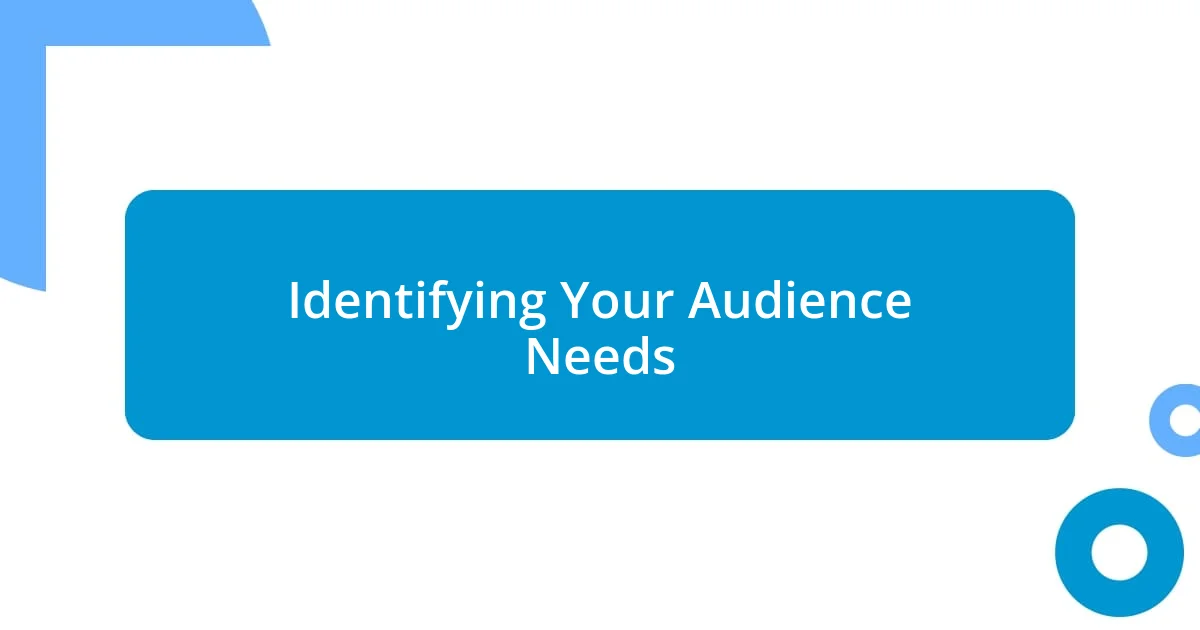
Identifying Your Audience Needs
Identifying your audience’s needs is crucial in shaping a successful data storytelling experience. I’ve often approached this by actively engaging in conversations with my audience before I present. For instance, during a recent project, I asked participants what specific questions they had about the data. Their insights guided my storytelling focus, ensuring I addressed their real concerns, rather than guessing their interests.
Another strategy I’ve adopted is segmenting the audience based on their expertise levels. Some people are data-savvy, while others might need more foundational explanations. In a workshop I led, I tailored my presentations by offering two different storylines—one that dove deep into technical details for the analysts, and another with broader insights for those less familiar with data. This not only kept everyone engaged but also empowered them to see the value in the information presented.
Finally, feedback plays an essential role in understanding audience needs. After presenting, I encouraged open dialogue, welcoming questions and comments. This two-way communication allowed me to gauge their level of understanding and adapt my approach in real-time. Have you ever received feedback that completely changed your perspective? I certainly have, and it’s incredibly valuable for refining your storytelling techniques.
| Audience Type | Content Focus |
|---|---|
| Data-Savvy Professionals | Technical details, in-depth analysis |
| General Audience | Broader insights, relatable stories |
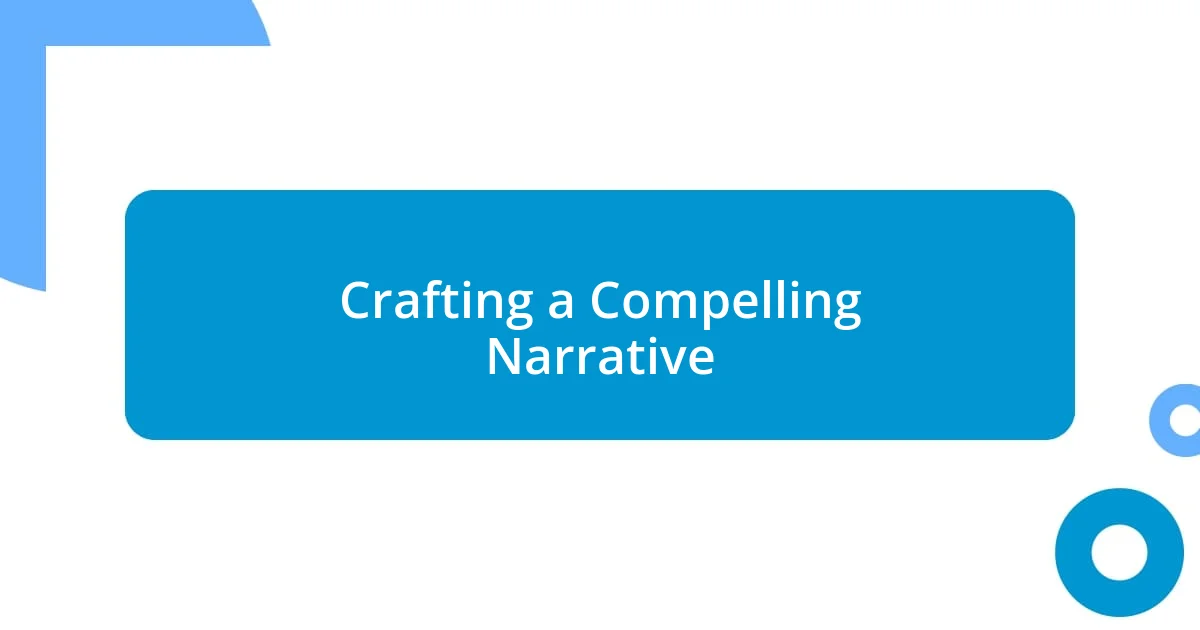
Crafting a Compelling Narrative
Crafting a compelling narrative in data storytelling is all about creating a journey for your audience. I remember working on a project where I had to present annual performance data. Instead of just showing slides filled with metrics, I framed the narrative around our team’s struggles and triumphs throughout the year. This approach not only made the data relatable but also drew my audience into the story—giving them a stake in the outcomes revealed by those numbers.
- Start with a captivating hook that connects emotionally, whether it’s a personal story or a real-life example.
- Use visuals that complement your narrative; a well-placed image can evoke feelings more powerfully than words alone.
- Build tension or conflict; reveal challenges that make the resolution—in your data—a satisfying conclusion.
- Conclude with a call-to-action or a reflective question, encouraging your audience to think deeper about the implications of the data.
In these moments, I’ve seen how sharing a little vulnerability in the narrative enhances connections. When I discuss setbacks alongside successes, it invites conversations and fosters genuine interest. By doing this, data transforms from mere figures into a story that resonates long after the presentation ends.
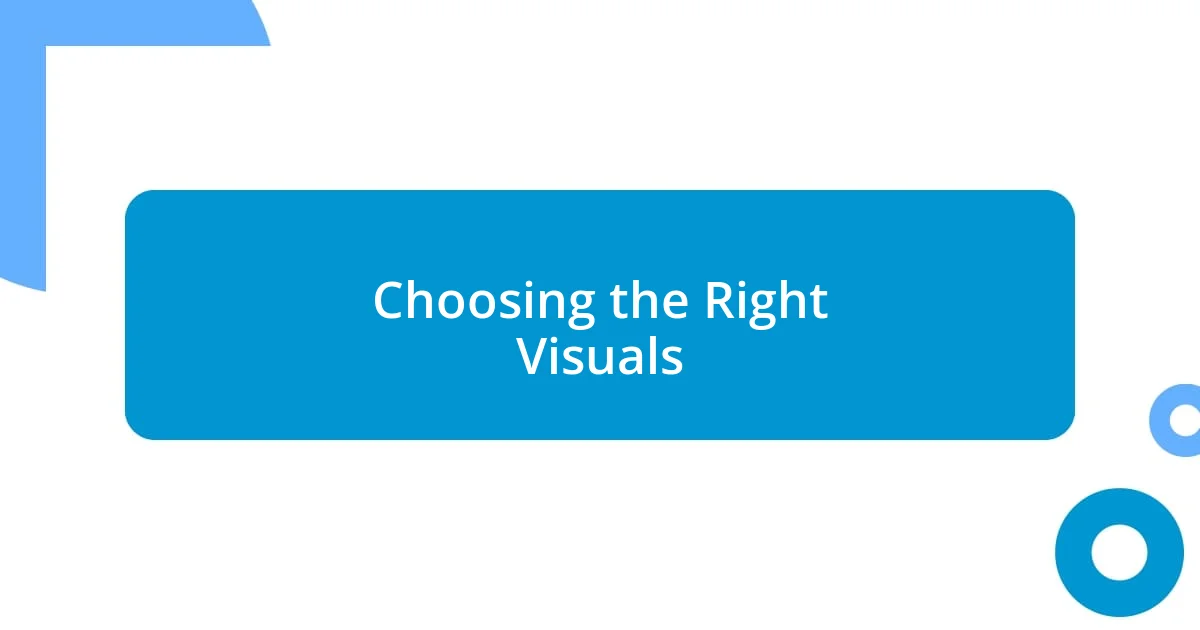
Choosing the Right Visuals
Choosing the right visuals can make or break your data storytelling experience. I’ve often found that a great way to start is to ask myself what emotions I want to evoke. For instance, during a quarterly report presentation, I used a simple line graph to highlight our revenue growth, but I complemented it with images that portrayed our team’s hard work. The combination not only showcased the data but also made it relatable and inspiring. Have you ever felt a surge of motivation from seeing familiar faces in a workplace achievement? That’s the magic of visuals!
When selecting visuals, clarity should always be a priority. In one presentation, I devoted an entire slide to a complex bar chart that confused even the most data-friendly colleagues. It was a humbling moment that taught me the importance of simplicity: sometimes, a single pie chart—or even a vivid icon—communicates a message far more effectively than a crowded slide. I now always strive to keep it clear: visual elements should enhance, not overwhelm.
Lastly, I’ve learned that context is key. As a case in point, during a non-profit meeting, I used a compelling photo of a community beneficiary alongside stats illustrating the impact of our programs. The visuals created a narrative that moved people to action. I understand now that visuals don’t only serve to inform; they can also stir emotions and inspire decisions. Do you remember a time when a simple visual changed your understanding of a concept? It’s those moments that remind me of the power behind effective visuals.
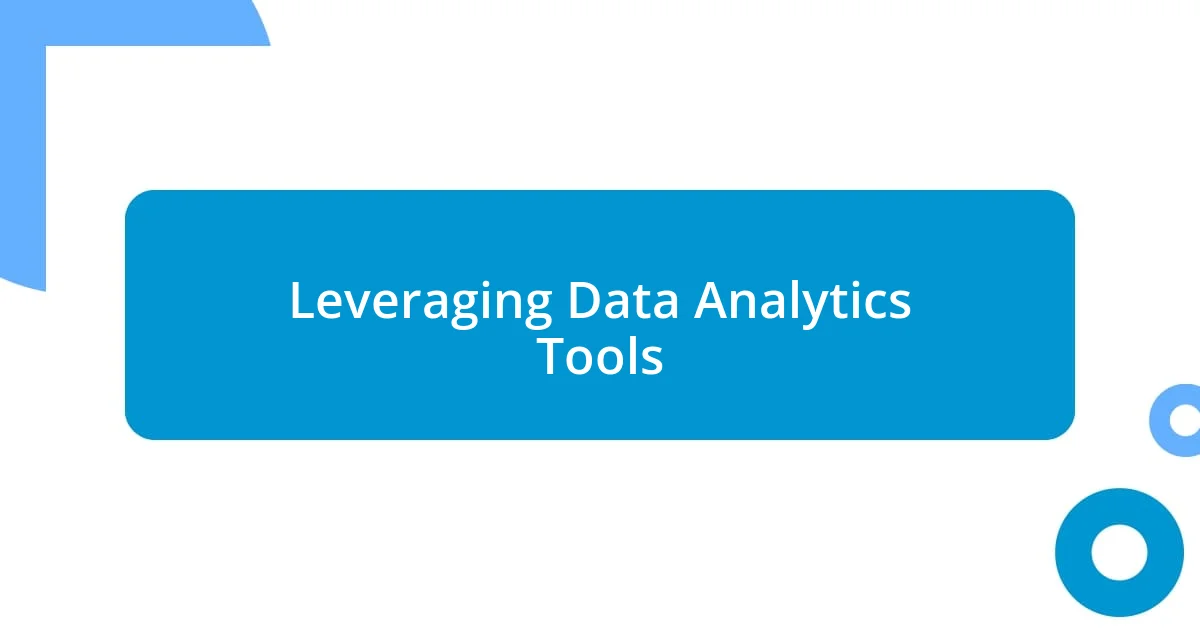
Leveraging Data Analytics Tools
Leveraging data analytics tools effectively can transform how I present and interpret data. For example, I once used a collaborative analytics platform to analyze customer feedback; the real-time insights boosted our decision-making process. I remember the thrill of seeing how quickly we identified trends—it’s amazing how the right tools can make data feel more alive and relevant!
On another occasion, I implemented a data visualization tool to generate an interactive dashboard for a marketing campaign. Instead of static reports, the dynamic visuals allowed my team to explore the data themselves. This hands-on experience not only engaged them but also sparked deeper discussions about our strategies. Have you ever experienced that “aha!” moment when you discover something unexpected while sifting through data? It’s those surprises that deepen our understanding and drive innovation.
Moreover, I’ve come to appreciate the importance of user-friendly interfaces in analytics tools. There was a time when I struggled with software that was too complex—frustration often led to overlooking key insights. Now, I always seek tools that balance functionality with simplicity, ensuring everyone on my team can extract meaningful information without a steep learning curve. What’s your experience with data tools? It’s these little triumphs that remind me how vital it is to choose the right tools to amplify the stories behind the numbers.
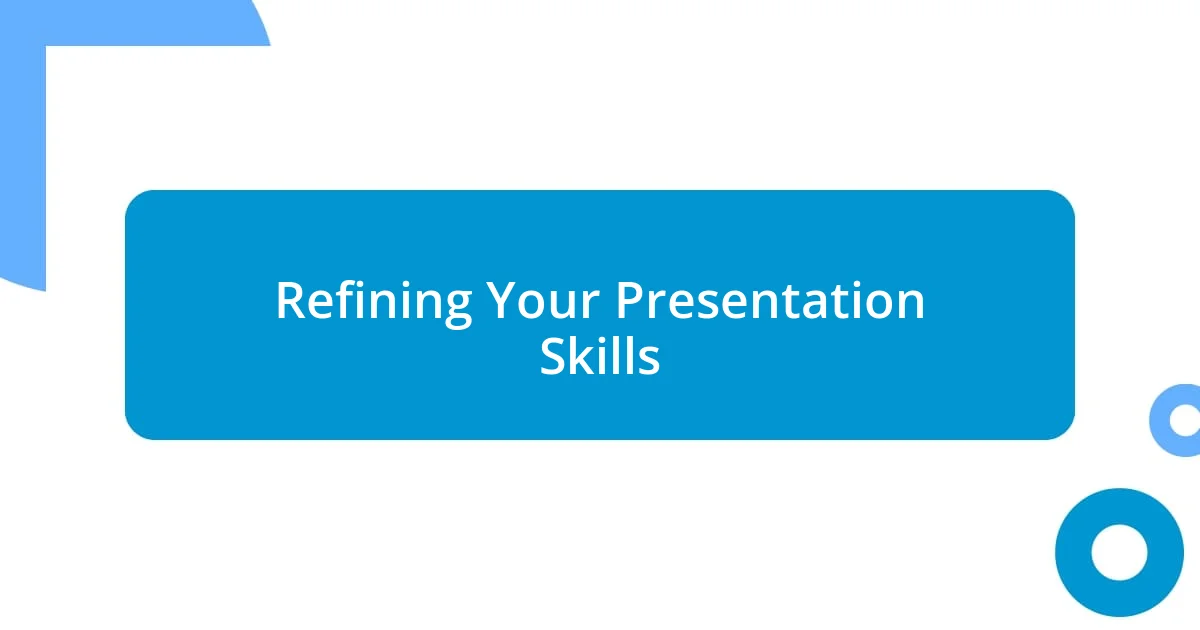
Refining Your Presentation Skills
Sharpening my presentation skills has been a game-changer in how I share data narratives. I recall a pivotal moment during a project pitch where I struggled initially to engage my audience. That experience taught me to embrace storytelling techniques—I began framing data within a relatable narrative, often starting with a personal anecdote that connected to the insights I was sharing. Have you ever noticed how a touching story can hold an audience’s attention far better than raw numbers? It genuinely makes a difference.
Practicing my delivery has also been essential. I vividly remember rehearsing a presentation multiple times in front of a mirror, focusing on my tone and body language. Adjusting my posture and using hand gestures made me feel more confident—and this, in turn, helped me connect better with my audience. Have you ever considered how your physical presence can impact the message you’re conveying? Eye contact and a genuine smile can create a shared moment that brings data to life.
Finally, embracing feedback has significantly refined my presentation approach. After a few presentations, I invited honest critiques from colleagues, which sometimes felt daunting but ultimately fueled my growth. One piece of advice that stuck with me was to lessen my reliance on jargon and make my insights accessible to everyone in the room. I think, isn’t it incredible how a few words of constructive criticism can guide us to be more effective communicators? Those insights not only transformed my presentations but also reinforced my belief in the power of connection through clarity.


